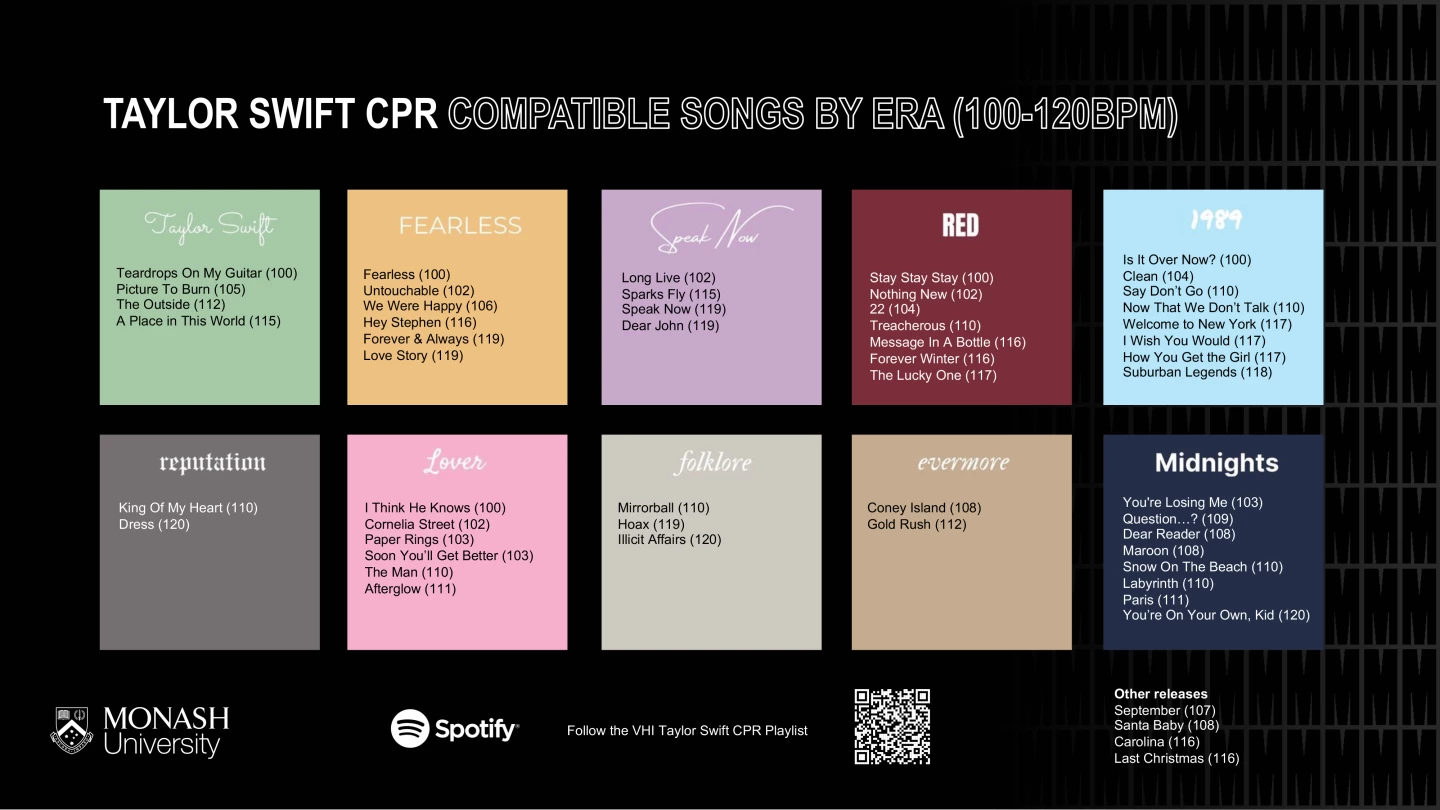Researchers have found that more than 50 Taylor Swift songs have an optimal tempo for delivering effective chest compressions during out-of-hospital cardiopulmonary resuscitation or CPR. They’re hoping that Swift’s music will teach fans – and others – how to do CPR in a way that could save a life.
Popular culture and medical science have converged, Dear Reader, thanks to the Fearless work of Monash University’s Victorian Heart Institute researchers, who’ve identified over 50 Taylor Swift songs with beats per minute (bpm) perfect for delivering effective CPR. It’s hoped that people, especially younger Swifties, will tap into Tay’s tunes to improve their CPR skills so they can Say Don’t Go or Soon You’ll Get Better if called upon.
Bystander CPR is critical to increasing survival from an out-of-hospital cardiac arrest. Someone in cardiac arrest is almost twice as likely to survive when witnesses perform CPR on them while emergency personnel are en route. However, effective CPR requires maintaining a chest compression rate of between 100 and 120 bpm. Listening to the songstress’ repertoire, they realized that quite a few fell within that golden range and presented their findings to Swiftposium 2024, an academic conference on Taylor Swift.
“A quarter of people who have a heart attack don’t make it to hospital in the first place, and we know that survival rates for cardiac arrest can be greatly improved with bystander CPR,” said Stephen Nicholls, director of the Victorian Heart Institute and the Victorian Heart Hospital. “Taylor Swift’s music is some of the most popular and influential of this generation. Music plays a pivotal role in maintaining effective CPR compressions. As iconic songs lose relevance, identifying new songs with optimal beats per minute (bpm) for training is crucial.”
For a long time, the Bee Gees song Stayin’ Alive has been used as the ‘metronome’ for timing CPR compressions. However, the song was released in 1977 and may not be known to many of today’s younger generation. It is better, say the researchers, to use a musical artist currently enjoying meteoric fame. Plus, at 103 bpm, Stayin’ Alive is at the lower end of the effectiveness spectrum; the ideal song is closer to 120.
“If you can utilize something that people love and use it to empower them to feel confident in learning a skill that could save someone, then that’s really powerful,” Nicholls said. “There’s a CPR-suitable song for every Swifty Era.”
The beat-perfect songs from Swift’s catalog number 54. The researchers have created a handy chart organized by era with the bpm for each song and, to make life easier, they’ve even created a Spotify playlist entitled ‘Taylor Swift CPR Compatible Songs’.

Swift’s music is already encouraging an interest in heart health-related activity, as evidenced by the recent viral ‘Eras Tour’ treadmill challenge, where fans run or walk on a treadmill for the entire three-hour tour setlist, just like Taylor professed to do in her Time Person of the Year 2023 article.
“Physical activity has great benefits for your heart health and reducing your risk of disease,” said Nicholls. “Even as little as 10 minutes a day is beneficial as you build up your fitness. You don’t need to be able to Shake It Off like Taylor on day one.”

The American Heart Association has jumped on the CPR bandwagon, too, posting on X (formerly Twitter) to endorse the use of Swift’s songs by younger fans to deliver effective chest compressions.
Source: Monash University







